
Shell Haven
Encyclopedia
Shell Haven was a port on the north bank of the Thames Estuary
at the eastern end of Thurrock
, Essex, England and then an oil refinery. The refinery closed in 1999 and the site was purchased by DP World who received planning consent in May 2007 for the new London Gateway
deep water container port at the site. The neighbouring Coryton Refinery
remains in operation.
The site, historically also referred to as Shellhaven was originally an inlet on the north bank of the Thames, about a mile to the west of Canvey Island
. This was the mouth of Shell Haven Creek, which runs east and south of the village of Fobbing
, and originally separated Corringham Marsh from Fobbing Marsh. To the east was Shell Haven House. Sources differ on when Shell Haven first became associated with the oil industry; the first edition Ordnance Survey
map of the early 19th century shows Oil Mill Farm a mile or so up Shell Haven Creek. Shell Haven was for over 80 years the site of a large Shell
oil refinery, but there seems to be no evidence for the company taking its name from the site.
In the 1850s a branch line was constructed from the London Tilbury and Southend Railway (LT&SR) to a new port immediately to the west of Shell Haven, to be known as Thames Haven (sometimes written Thameshaven). The name of Shell Haven would probably have been eclipsed, but for the failure of Thames Haven to prosper, and the later arrival of the Shell
oil company.
In 1895 the ammunition firm Kynoch
s purchased Borley Farm, to the east of Shell Haven Creek, in order to build an explosives factory. This opened in 1897, with a small estate called Kynochtown. Kynochs also built the Corringham Light Railway
(CLR), with a passenger branch from the works to Corringham
and a goods branch to the LT&SR at Thames Haven. The Kynoch works closed in 1919. The site and CLR were taken over by coal merchants Cory Brothers Ltd of Cardiff to build an oil storage depot, with Kynochtown being renamed Coryton. The oil depot eventually became Coryton Refinery
(run from 1950 until recently by Mobil
and its antecedents), which remains in production, between Shell Haven Creek and Hole Haven to the east.
Shell Oil first arrived in the form of the Asiatic Petroleum Company
Ltd, a sales company formed by Royal Dutch Petroleum and the British company Shell Transport and Trading Company, prior to their merger as Royal Dutch Shell. A licence was obtained in 1912 to store petroleum at Shell Haven, in iron tanks, each containing not more than 4,000 tonnes. The maximum storage allowed for the whole site was 80,000 tonnes. Refinery operations began on a 40 hectare (100 acre) site in 1916 with a distillation
plant which produced fuel oil
for the Admiralty
. In 1919 this unit was converted to manufacture road surfacing bitumen. In 1925, a bench still was erected for the manufacture of lubricating oils; the first high viscosity oils were produced in 1937.
Other plants were erected before the outbreak of war, including a blending plant for producing horticultural chemical products.
During World War 2 the refineries and oil storage tanks at Thames Haven, Shell Haven and Coryton became a sitting target for air raids, notably in September 1940 during the Battle of Britain
.
In 1946 a plant producing high grade paraffin wax for candles, paper, etc. was commissioned. In 1947 expansion began on a 400 hectare (1,000 acre) site west of the original refinery.
In 1948 financial sanction was approved by the Board of Shell Petroleum Co Ltd for the construction of a new large crude oil refinery, based primarily on the processing of Kuwait crude.
The facilities were to include:
In 1950 the Crude Distillation Unit, the Doctor Treater and MP Boilers 3, 5 and 6 were commissioned.
Subsequently various units were added to produce valuable hydrocarbons from the distillation residue. In 1956 a catalytic reforming
'Platformer' was brought into service and in the same year, a petroleum chemicals unit to manufacture alkylbenzenes, the basis of household detergents. A second crude distillation unit was commissioned in 1959, and a second catalytic reformer in 1967. A kerosene hydrotreater was commissioned in 1972 and in 1977 a third reformer. In 1979 a hydrocracking unit was added to increase the proportion of light distillates. A new bitumen plant started production in 1981.
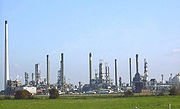 In 1992, a major capital investment was completed, adding a 'Naphtha Minus' complex which contained an isomerisation
In 1992, a major capital investment was completed, adding a 'Naphtha Minus' complex which contained an isomerisation
unit, benzene
recovery and gas turbine
power generation. A new Control Centre was added. By then the plant had a capacity of 4.6 million tonnes per annum, and covered 800 hectares (2,000 acres), with a 27 km (16.8 mi) perimeter and its own generating plant, emergency and other services. It had five jetties, handling tankers of up to 300,000 tons capacity. The refinery delivered products by road and ship and UK oil pipeline network
.
The Shell refinery closed in 1999. A team consisting of operations and engineering personnel were picked from the workforce to carry out decommissioning and oversee the demolition of the refinery. Shell Haven Refinery was De-Commissioned and Demolished, apart from The Bitumen Plant and some Storage Tanks.
In 2006 the site was purchased by DP World, one of the largest marine terminal operators in the world, as part of the company’s purchase of P&O
. In May 2007, DP World received outline planning consent for a major new deepwater port on the site, known as London Gateway
. In addition to the new port, the development will include one of Europe’s largest logistics parks, providing access to London, the South East and the rest of the UK.
In May 2008, the Department for Transport
issued a ‘Harbour Empowerment Order’ for London Gateway
, which provided official and statutory powers for the new port and established London Gateway as a legally recognised authority. DP World is now set to invest over £1.5bn to develop the project over the next 10 to 15 years.
The Bitumen Unit was in the process of being decommissioning in 2010.
Thames Estuary
The Thames Mouth is the estuary in which the River Thames meets the waters of the North Sea.It is not easy to define the limits of the estuary, although physically the head of Sea Reach, near Canvey Island on the Essex shore is probably the western boundary...
at the eastern end of Thurrock
Thurrock
Thurrock is a unitary authority with borough status in the English ceremonial county of Essex. It is part of the London commuter belt and an area of regeneration within the Thames Gateway redevelopment zone. The local authority is Thurrock Council....
, Essex, England and then an oil refinery. The refinery closed in 1999 and the site was purchased by DP World who received planning consent in May 2007 for the new London Gateway
London Gateway
London Gateway is a major new development under construction on the north bank of the River Thames in Thurrock, Essex. It comprises a large new deep-water port, which will be able to handle the biggest container ships in the world, as well as one of Europe’s largest logistics parks, providing...
deep water container port at the site. The neighbouring Coryton Refinery
Coryton Refinery
Coryton Refinery is an oil refinery in Essex, England, situated on the estuary of the River Thames some from the centre of London.The refinery is located between Shell Haven Creek and Hole Haven Creek, which separates Canvey Island from the mainland....
remains in operation.
History
Shell Haven was mentioned in Samuel Pepys Diary on 10 June 1667.The site, historically also referred to as Shellhaven was originally an inlet on the north bank of the Thames, about a mile to the west of Canvey Island
Canvey Island
Canvey Island is a civil parish and reclaimed island in the Thames estuary in England. It is separated from the mainland of south Essex by a network of creeks...
. This was the mouth of Shell Haven Creek, which runs east and south of the village of Fobbing
Fobbing
Fobbing is a small village in Thurrock, Essex, England and one of Thurrock's traditional parishes. It is located between Basildon and Corringham, and is also close to Stanford-le-Hope....
, and originally separated Corringham Marsh from Fobbing Marsh. To the east was Shell Haven House. Sources differ on when Shell Haven first became associated with the oil industry; the first edition Ordnance Survey
Ordnance Survey
Ordnance Survey , an executive agency and non-ministerial government department of the Government of the United Kingdom, is the national mapping agency for Great Britain, producing maps of Great Britain , and one of the world's largest producers of maps.The name reflects its creation together with...
map of the early 19th century shows Oil Mill Farm a mile or so up Shell Haven Creek. Shell Haven was for over 80 years the site of a large Shell
Royal Dutch Shell
Royal Dutch Shell plc , commonly known as Shell, is a global oil and gas company headquartered in The Hague, Netherlands and with its registered office in London, United Kingdom. It is the fifth-largest company in the world according to a composite measure by Forbes magazine and one of the six...
oil refinery, but there seems to be no evidence for the company taking its name from the site.
In the 1850s a branch line was constructed from the London Tilbury and Southend Railway (LT&SR) to a new port immediately to the west of Shell Haven, to be known as Thames Haven (sometimes written Thameshaven). The name of Shell Haven would probably have been eclipsed, but for the failure of Thames Haven to prosper, and the later arrival of the Shell
Royal Dutch Shell
Royal Dutch Shell plc , commonly known as Shell, is a global oil and gas company headquartered in The Hague, Netherlands and with its registered office in London, United Kingdom. It is the fifth-largest company in the world according to a composite measure by Forbes magazine and one of the six...
oil company.
In 1895 the ammunition firm Kynoch
Kynoch
Kynoch was a manufacturer of ammunition, later incorporated into ICI but remaining as a brand name for sporting cartridges.-History:Kynoch was established in Witton in Birmingham in 1862 by Scottish entrepreneur George Kynoch when he opened a percussion cap factory in Witton. In 1895 he built an...
s purchased Borley Farm, to the east of Shell Haven Creek, in order to build an explosives factory. This opened in 1897, with a small estate called Kynochtown. Kynochs also built the Corringham Light Railway
Corringham Light Railway
The Corringham Light Railway served the town Corringham, Essex, England. It was incorporated on 10 July 1899 and opened to freight on 1 January 1901 and to passengers on 22 June 1901...
(CLR), with a passenger branch from the works to Corringham
Corringham, Essex
Corringham is a small English town within the unitary authority of Thurrock and one of the traditional parishes. It is situated in the east of the borough of Thurrock and has over time come to be considered an area within the larger neighbouring town of Stanford-Le-Hope. The parish church...
and a goods branch to the LT&SR at Thames Haven. The Kynoch works closed in 1919. The site and CLR were taken over by coal merchants Cory Brothers Ltd of Cardiff to build an oil storage depot, with Kynochtown being renamed Coryton. The oil depot eventually became Coryton Refinery
Coryton Refinery
Coryton Refinery is an oil refinery in Essex, England, situated on the estuary of the River Thames some from the centre of London.The refinery is located between Shell Haven Creek and Hole Haven Creek, which separates Canvey Island from the mainland....
(run from 1950 until recently by Mobil
Mobil
Mobil, previously known as the Socony-Vacuum Oil Company, was a major American oil company which merged with Exxon in 1999 to form ExxonMobil. Today Mobil continues as a major brand name within the combined company, as well as still being a gas station sometimes paired with their own store or On...
and its antecedents), which remains in production, between Shell Haven Creek and Hole Haven to the east.
Shell Oil first arrived in the form of the Asiatic Petroleum Company
Asiatic Petroleum Company
Asiatic Petroleum Company was a joint venture between the Shell and Royal Dutch oil companies founded in 1903. It operated in Asia in the early twentieth century. The corporate headquarters were on The Bund in Shanghai, China. The division tested the limits of corporate liability in the Lennard's...
Ltd, a sales company formed by Royal Dutch Petroleum and the British company Shell Transport and Trading Company, prior to their merger as Royal Dutch Shell. A licence was obtained in 1912 to store petroleum at Shell Haven, in iron tanks, each containing not more than 4,000 tonnes. The maximum storage allowed for the whole site was 80,000 tonnes. Refinery operations began on a 40 hectare (100 acre) site in 1916 with a distillation
Distillation
Distillation is a method of separating mixtures based on differences in volatilities of components in a boiling liquid mixture. Distillation is a unit operation, or a physical separation process, and not a chemical reaction....
plant which produced fuel oil
Fuel oil
Fuel oil is a fraction obtained from petroleum distillation, either as a distillate or a residue. Broadly speaking, fuel oil is any liquid petroleum product that is burned in a furnace or boiler for the generation of heat or used in an engine for the generation of power, except oils having a flash...
for the Admiralty
Admiralty
The Admiralty was formerly the authority in the Kingdom of England, and later in the United Kingdom, responsible for the command of the Royal Navy...
. In 1919 this unit was converted to manufacture road surfacing bitumen. In 1925, a bench still was erected for the manufacture of lubricating oils; the first high viscosity oils were produced in 1937.
Other plants were erected before the outbreak of war, including a blending plant for producing horticultural chemical products.
During World War 2 the refineries and oil storage tanks at Thames Haven, Shell Haven and Coryton became a sitting target for air raids, notably in September 1940 during the Battle of Britain
Battle of Britain
The Battle of Britain is the name given to the World War II air campaign waged by the German Air Force against the United Kingdom during the summer and autumn of 1940...
.
In 1946 a plant producing high grade paraffin wax for candles, paper, etc. was commissioned. In 1947 expansion began on a 400 hectare (1,000 acre) site west of the original refinery.
In 1948 financial sanction was approved by the Board of Shell Petroleum Co Ltd for the construction of a new large crude oil refinery, based primarily on the processing of Kuwait crude.
The facilities were to include:
- A Crude Distillation Unit, with a design intake of 6,000 tonnes/day of Kuwait Crude. It was given the designation CDU1.
- A High Vacuum Unit with a design intake of 3,500 tonnes/day of Kuwait Long Residue. Designated HVU for CCF (cat cracker feed).
- A Thermal Reformer with a design intake of 1,200 tonnes/day Kuwait Naphtha.
- A Gasoline Doctor Treater
- Three 17bar Steam Boilers (MP Boilers 3, 5 and 6) and a once through salt cooling water system.
In 1950 the Crude Distillation Unit, the Doctor Treater and MP Boilers 3, 5 and 6 were commissioned.
Subsequently various units were added to produce valuable hydrocarbons from the distillation residue. In 1956 a catalytic reforming
Catalytic reforming
Catalytic reforming is a chemical process used to convert petroleum refinery naphthas, typically having low octane ratings, into high-octane liquid products called reformates which are components of high-octane gasoline...
'Platformer' was brought into service and in the same year, a petroleum chemicals unit to manufacture alkylbenzenes, the basis of household detergents. A second crude distillation unit was commissioned in 1959, and a second catalytic reformer in 1967. A kerosene hydrotreater was commissioned in 1972 and in 1977 a third reformer. In 1979 a hydrocracking unit was added to increase the proportion of light distillates. A new bitumen plant started production in 1981.

Isomerisation
In chemistry isomerisation is the process by which one molecule is transformed into another molecule which has exactly the same atoms, but the atoms are rearranged e.g. A-B-C → B-A-C . In some molecules and under some conditions, isomerisation occurs spontaneously...
unit, benzene
Benzene
Benzene is an organic chemical compound. It is composed of 6 carbon atoms in a ring, with 1 hydrogen atom attached to each carbon atom, with the molecular formula C6H6....
recovery and gas turbine
Gas turbine
A gas turbine, also called a combustion turbine, is a type of internal combustion engine. It has an upstream rotating compressor coupled to a downstream turbine, and a combustion chamber in-between....
power generation. A new Control Centre was added. By then the plant had a capacity of 4.6 million tonnes per annum, and covered 800 hectares (2,000 acres), with a 27 km (16.8 mi) perimeter and its own generating plant, emergency and other services. It had five jetties, handling tankers of up to 300,000 tons capacity. The refinery delivered products by road and ship and UK oil pipeline network
UK oil pipeline network
The United Kingdom Oil Pipeline is an oil products pipeline opened in 1969 and connecting the two Shell refineries of Stanlow and Shell Haven...
.
The Shell refinery closed in 1999. A team consisting of operations and engineering personnel were picked from the workforce to carry out decommissioning and oversee the demolition of the refinery. Shell Haven Refinery was De-Commissioned and Demolished, apart from The Bitumen Plant and some Storage Tanks.
In 2006 the site was purchased by DP World, one of the largest marine terminal operators in the world, as part of the company’s purchase of P&O
Peninsular and Oriental Steam Navigation Company
The Peninsular and Oriental Steam Navigation Company, which is usually known as P&O, is a British shipping and logistics company which dated from the early 19th century. Following its sale in March 2006 to Dubai Ports World for £3.9 billion, it became a subsidiary of DP World; however, the P&O...
. In May 2007, DP World received outline planning consent for a major new deepwater port on the site, known as London Gateway
London Gateway
London Gateway is a major new development under construction on the north bank of the River Thames in Thurrock, Essex. It comprises a large new deep-water port, which will be able to handle the biggest container ships in the world, as well as one of Europe’s largest logistics parks, providing...
. In addition to the new port, the development will include one of Europe’s largest logistics parks, providing access to London, the South East and the rest of the UK.
In May 2008, the Department for Transport
Department for Transport
In the United Kingdom, the Department for Transport is the government department responsible for the English transport network and a limited number of transport matters in Scotland, Wales and Northern Ireland which are not devolved...
issued a ‘Harbour Empowerment Order’ for London Gateway
London Gateway
London Gateway is a major new development under construction on the north bank of the River Thames in Thurrock, Essex. It comprises a large new deep-water port, which will be able to handle the biggest container ships in the world, as well as one of Europe’s largest logistics parks, providing...
, which provided official and statutory powers for the new port and established London Gateway as a legally recognised authority. DP World is now set to invest over £1.5bn to develop the project over the next 10 to 15 years.
The Bitumen Unit was in the process of being decommissioning in 2010.
Shell Haven Refinery
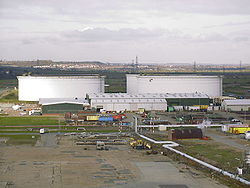 |
Crude Oil Tanks The Crude that was brought in by oil tankers was then pumped into 100,000 ton capacity tanks seen in the back of the photo. The buildings in front of the tanks were the refinery Workshops and Stores. |
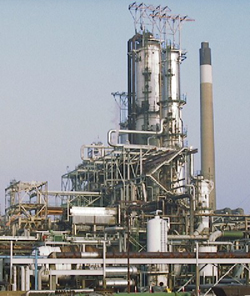 |
Crude Distiller 1 Crude was brought in by oil tankers to the jetties, usually 'B Jetty'. This was then pumped into 100,000 ton capacity tanks. Once the tanks had been checked for water it was then pumped to the Crude Distiller. It was passed through a Desalter Desalter A desalter is a process unit on an oil refinery that removes salt from the crude oil. The salt is dissolved in the water in the crude oil, not in the crude oil itself. The desalting is usually the first process in crude oil refining. The salt content after the desalter is usually measured in PTB -... unit which washed out salt from the crude oil before it entered the distillation unit. The distiller produced long residue, waxy distillate, butane Butane Butane is a gas with the formula C4H10 that is an alkane with four carbon atoms. The term may refer to any of two structural isomers, or to a mixture of them: in the IUPAC nomenclature, however, butane refers only to the unbranched n-butane isomer; the other one being called "methylpropane" or... , propane Propane Propane is a three-carbon alkane with the molecular formula , normally a gas, but compressible to a transportable liquid. A by-product of natural gas processing and petroleum refining, it is commonly used as a fuel for engines, oxy-gas torches, barbecues, portable stoves, and residential central... , kerosene Kerosene Kerosene, sometimes spelled kerosine in scientific and industrial usage, also known as paraffin or paraffin oil in the United Kingdom, Hong Kong, Ireland and South Africa, is a combustible hydrocarbon liquid. The name is derived from Greek keros... , gas oil (Heavy and Medium)and naphtha Naphtha Naphtha normally refers to a number of different flammable liquid mixtures of hydrocarbons, i.e., a component of natural gas condensate or a distillation product from petroleum, coal tar or peat boiling in a certain range and containing certain hydrocarbons. It is a broad term covering among the... . methane Methane Methane is a chemical compound with the chemical formula . It is the simplest alkane, the principal component of natural gas, and probably the most abundant organic compound on earth. The relative abundance of methane makes it an attractive fuel... and other waste gasses produced went to the refinery flare system to be recovered and burnt as fuel in the refinery furnaces. |
 |
The High Vacuum Unit was originally designed to process 3,500 tonnes/day of Kuwait Long Residue. The Vacuum was produced using steam ejectors with salt cooling water condensers. The HVU produced three streams. Short Residue, Waxy Distillate and Blowing Flux. Short Residue was either feed for the Bitumen or used to blend fuel oil. Blowing Flux was used in the production of Blown Bitumen. In later years the HVU run on North Sea Long Residue. When the Hydrocracker was commissioned in 1979 the HVU's Waxy Distillate became the HCU's feed. The operators called the HVU, feed prep. |
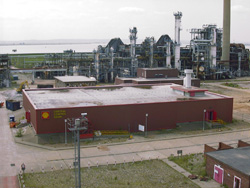 |
The Central Control Room was commissioned in 1992. It was built to provide better control and communications between the process units. Most of the process units apart from the Sulphur recovery were controlled from here. The Tank Farm and Waterfront were controlled from Road 6A Control Room. The Boilerhouse had its own Control Room. The process plant in the background of the photo is the Hydrocracker. |
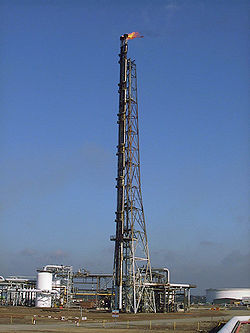 |
The Flare System was designed to deal with any excess gas produced by the process units. The process units that produced gas exported that to either the high pressure gas main run at 10 bar Bar (unit) The bar is a unit of pressure equal to 100 kilopascals, and roughly equal to the atmospheric pressure on Earth at sea level. Other units derived from the bar are the megabar , kilobar , decibar , centibar , and millibar... or the low pressure gas main run at 4 bar. The process units could also export directly to the flare system. Relief valves set to protect linework or equipment also would open into the flare system should the pressure exceed the set pressure. There were two flare stacks, each with its own knock out vessels. These were designed to remove any hydrocarbons from the gas. There was a compressor in the system downstream of the knock out vessels that sent any gas back to the refinery gas mains. Should the refinery furnaces be unable to deal with this gas, it would then be burnt via the stacks. When this happened steam Steam Steam is the technical term for water vapor, the gaseous phase of water, which is formed when water boils. In common language it is often used to refer to the visible mist of water droplets formed as this water vapor condenses in the presence of cooler air... at a preset ratio would be injected with the gas to allow it to burn cleanly. The priority of these stacks were determined by a water level in the vessels that the gas passed through prior to entering the stacks. |
 |
Cooling Water Pumphouse Abbreviated CWPH. The long thin building is the Cooling Water Pumphouse. Some of the process units used water from the Thames to cool the process streams through heat exchangers. The water passed through rotating screens prior to being pumped to the units. The pumps then fed the water into underground ducting which had offtakes to each of the process unit that used it. The more modern units had fin fan cooling. The CWPH also provided water to a firemain, which was a pipeline that ran around the refinery to be used in the event of a fire. This had dedicated pumps, separate from the cooling water system. |
External links
- Vision of Britain – Old OS Maps
- Thurrock council -Thurrock Heritage – Factfiles 49 – Corringham Light railway
- About Shell – The Shell history – the beginnings
- An account of the visit to the Shell Haven Oil Refinery 1990
- Institute of Petroleum Interactive Guide to UK Refineries – Shell Haven (Shell)
- London Gateway Planning Inquiry
- P&O London Gateway decision press release

